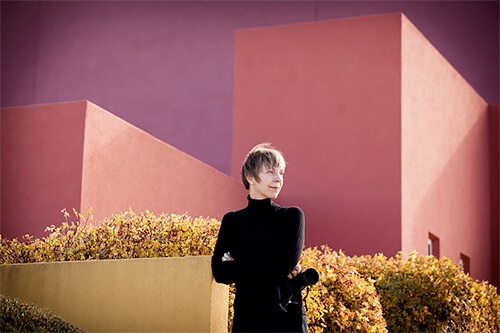Photographer Natalie Christensen has an inimitable, and enchanting, focus on the exploration of
the more banal peripheral landscapes that often go unnoticed by the casual observer. "I quickly
became aware that these isolated moments in the suburban landscape were rich with metaphor.
Closed and open doors, empty parking lots and forgotten swimming pools draw me to a scene; yet it
was my reactions to these objects and spaces that elicited interpretation and projection."
Based in Santa Fe, New Mexico, United States, she has exhibited her photographs in the U.S. and
internationally, including Santa Fe, New York, Brooklyn, Los Angeles, London, Berlin and
Barcelona. She was recently honored as an invited guest of the Embassy of the United Arab
Emirates in Washington, D.C. and joined a select delegation of architects, architectural
photographers and curators for a one-week cultural tour of the UAE.
Christensen had worked as a psychotherapist for over 25 years and was particularly influenced by
the theories of depth psychologist Carl Jung. This influence is evident in her photographs, as
shadows and psychological metaphors are favored subjects.
"The symbols and spaces in my images are an invitation to explore a rich world that is concealed
from consciousness, and an enticement to contemplate narratives that have no remarkable life yet
tap into something deeply familiar to our experience; often disturbing, sometimes
amusing...unquestionably present."
In Santa Fe, her work is inspired by commonplace architecture and streetscapes. She realizes that
the places she frequents for her images are probably not what people visualize when they think of
Santa Fe, a major tourist destination with a carefully cultivated image. "I don't have to go
anywhere special to make my photography; instead I find my images around shopping centers,
apartment complexes and office parks." Choosing to shoot in locations that may be viewed as
uninteresting or even visually off-putting, Christensen finds this challenging, to "see" something
hidden in plain sight, noting "it is our nature to ignore what is unpleasant, but sometimes I get a
glimpse of the sublime in these ordinary places. When I find it, it feels like I have discovered gold."
Christensen is repeatedly drawn to the swimming pool as a metaphor for the unconscious. In
American culture, pools symbolize the luxury of leisure. Yet she also sees a darker interpretation -
evoking repressed desires, unexplained tension and looming disaster. "These photographs of a
manufactured oasis suggest a binary connection between the world above and the world below,
linking submersion in water with the workings of the subconscious."
She dismantles all of these scenes to color fields, geometry and shadow. She shoots every day and
is almost never without a camera.
The Royal Photographic Society recently presented her artwork in a traveling museum exhibition
throughout the United Kingdom, and had her as a guest lecturer. She led a photography workshop
there, as well at Meow Wolf in Santa Fe. Christensen has participated in collaborative site-specific
projects at Iconic Standard Vision Billboard, Los Angeles; El Rey Court, Santa Fe; University of
New Mexico, Albuquerque; and Peckham Levels, London.
She has been named one of "Ten Photographers to Watch" by the Los Angeles Center of Digital
Art. As one of five invited photographers for "The National 2018: Best of Contemporary
Photography" at the Fort Wayne Museum of Art, Indiana, her work was purchased for the
permanent collection. Christensen was also the Purchase Prize recipient of the 33rd Annual
International Exhibition at the University of Texas at Tyler.
Christensen's photographs are in private and corporate collections. Her work has received awards,
including top finalist of 48,000 entries for the Smithsonian's 15th Annual Photo Contest and
Honorable Mentions for the Julia Margaret Cameron Award and the Chromatic Awards. Global
media have taken notice, with features in, among others, Xi Draconis Books; LandEscape Art
Review, United Kingdom; Better Photography Magazine, India; Art Reveal Magazine; Magazine
43, Philippines, Germany and Hong Kong; Site Unseen; Lens Culture; All About Photo and
Women in Photography.
Statement
I live in Santa Fe New Mexico where my work is inspired by commonplace architecture and streetscapes. I shoot every day and am almost never without my camera. I don't have to go anywhere special to make my photography; instead I find my images around shopping centers, apartment complexes and office parks. I dismantle these scenes to color fields, geometry and shadow. The places I frequent for my images are probably not what people visualize when they think of the city I live in, a major tourist destination with a carefully cultivated image. I choose to shoot in locations that may be viewed as uninteresting or even visually off-putting. This is exciting and challenging for me, to "see" something hiding in plain sight. Much of my professional life has been spent as a psychotherapist, and my photography as an extension of that work. Both have called me to explore what is hidden from view, those aspects of the self or the environment that we want to turn away from or simply avoid. I suspect it is our nature to ignore what is unpleasant, but sometimes I get a glimpse of the sublime in these ordinary places. When I find it, it feels like I have discovered gold.
Selected Books on

